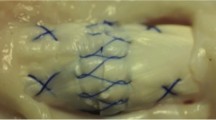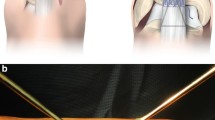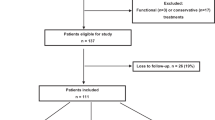Abstract
Background
Zone 2 flexor tendon injuries are prone to poor results following repair due to adhesions. Different repair methods and physiotherapy protocols have been devised to improve outcomes, with variable results. Hyaluronic acid (HA) is a polysaccharide produced by the innermost layer of the tendon sheath that facilitates gliding in zones where the sheath is continuous.
Methods
Sixty-two flexor tendons that were repaired using a double-stranded core suture were divided between groups A (n = 32) and B (n = 30). In the former, non-cross-linked HA was repeatedly instilled at the repair site, with a total of three injections per digit. The repair outcomes were assessed using the Strickland criteria, the ratio of total active motion to total passive motion (TAM/TPM), and active range of motion (AROM) for individual joints.
Results
A total of 31.1% of group A patients had excellent to good outcomes in contrast to 13.3% in group B. The mean difference in TAM was 105° in group A and 71° in group B (p value ˂ 0.05). The mean TAM/TPM was 0.65 in group A and 0.56 in group B (p value = 0.06).
Conclusions
HA significantly improves the results of flexor tendon repair in zone 2.
Level of Evidence: I.




Similar content being viewed by others
References
Verdan CE (1972) Half a century of flexor tendon surgery: current status and changing philosophies. J Bone Surg Am 54:472–491
Martin E. Flexor tendon injury, acute injuries. In Wolfe SW, Hotchkiss RN, Pederson WC, Kozin SH (ed.) Green’s operative hand surgery 7th edition, 2017. Churchill Livingstone/Elsevier. P. 189–201
Sinnatmby CS (2011) Wrist and hand, upper limb. In: Sinnatmby CS (ed) Last’s anatomy. Elsevier, Churchill Livingstone, pp 86–90
Bluman EM, Allen SD, Fadale PD (2006) Tendon repair and regeneration: an overview. In Walsh WR (ed.), Repair and regeneration of ligaments, tendons, and joint capsule. . Humana Press. P. 3:8
Wu YF, Tang JB (2013) Tendon healing, edema, and resistance to flexor tendon gliding: clinical implications. Hand Clin 29:167–178
Sebastin SJ, Ho A, Karjalainen T, Chung KC (2013) History and evolution of Kessler repair. J Hand Surg 38A:552–561
Seiler JG III.(2017) Flexor tendon injury. In Wolfe SW, Hotchkiss RN, Pederson WC, Kozin SH, Cohen MS (ed.) Green’s operative hand surgery 7th edition; Elsevier. P. 183–230
Formby M (2006) Flexor tendon repair. In: Burke SL, Higgins JP, McClinton MA, Saunders RJ, Valdata L (eds) Hand and upper extremity rehabililitation, a practical guide. Elsevier, Churchill Livingstone, pp 227–244
Zhao C, Amadio PC, Paillard P (2004) Digital resistance and tendon strength during the first week after flexor digitorum profundus tendon repair in a canine model in vivo. J Bone Joint Surg Am 86(2):320–327
Coats RW II, Echevarria-Ore JC, Mass DP (2005) Acute flexor tendon repairs in zone II. Hand Clin 21(2):173–179
Lawrence TM, Davis TR (2005) A biomechanical analysis of suture materials and their influence on a four-strand flexor tendon repair. J Hand Surg [Am] 30(4):836–841
Strickland JW (1985) Results of flexor tendon surgery in zone II. Hand Clin 1(1):167–179
Tang JB (2013) Outcomes and evaluation of flexor tendon repair. Hand Clin 29:251–259
St Onge R, Weiss C, Denlinger JL, Balazs EA (1980) A preliminary assessment of Na-hyaluronate injection into “no man’s land” for primary flexor tendon repair. Clin Orthop Relat Res (146):269–275
Amiel D, Ishizue K, Billings E Jr, Wiig M, Vande B Jr, Akeson WH et al (1989) Hyaluronan kin flexor tendon repair. J Hand Surg [Am] 14A:837–843
Meyers SA, Seaber AV, Glisson RR, Nunley JA (1989) Effect of hyaluronic acid/chondroitin sulfate on healing of full-thickness tendon lacerations in rabbits. J Orthop Res 7:683–689
Hagberg L, Tengblad A, Gerdin B (1991) Elimination of exogenously injected sodium hyaluronate from rabbit flexor tendon sheaths. J Orthop Res 9:792–797
Miller JA, Ferguson RL, Powers DL, Burns JW, Shalaby SW (1997) Efficacy of hyaluronic acid/nonsteroidal anti-inflammatory drug systems in preventing postsurgical tendon adhesions. J Biomed Mater Res 38:25–33
Thomas SC, Jones LC, Hungerford DS (1986) Hyaluronic acid and its effect on postoperative adhesions in the rabbit flexor tendon: a preliminary look. Clin Orthop (206):281–289
Gaughan EM, Nixon AJ, Krook LP, Yeager AE, Mann KA, Mohammed H, Bartel DL (1991) Effects of sodium hyaluronate on tendon healing and adhesion formation in horses. Am J Vet Res 52:764–773
Foland JW, Trotter GW, Powers BE, Wrigley RH, Smith FW (1992) Effect of sodium hyaluronate in collagenase-induced superficial digital flexor tendinitis in horses. Am J Vet Res 53:2371–2376
Hagberg L, Gerdin B (1992) Sodium hyaluronate as an adjunct in adhesion prevention after flexor tendon surgery in rabbits. J Hand Surg [Am] 17-A:935–941
Salti NI, Tuel RJ, Mass DP (1993) Effect of hyaluronic acid on rabbit profundus flexor tendon healing in vitro. J Surg Res 55:411–415
Wiig M, Abrahamsson SO, Lundborg G (1997) Tendon repair— cellular activities in rabbit deep flexor tendons and surrounding synovial sheaths and the effects of hyaluronan: an experimental study in vivo and in vitro. J Hand Surg 22A:818–825
Tuncay I, Ozbek H, Atik B, Ozen S, Akpinar F (2002) Effects of hyaluronic acid on postoperative adhesion of tendocalcenous surgery: an experimental study in rats. J Foot Ankle Surg 41:104–108
Meloni F, Milia F, Cavazzuti M, Doria C, Lisai P, Profili S, Meloni GB (2008) Clinical evaluation of sodium hyaluronate in the treatment of patients with supraspinatus tendinosis under echographic guide: experimental study of periarticular injections. Eur J Radiol 68:170–173
Özgenel GY (2004) The effects of a combination of hyaluronic and amniotic membrane on the formation of peritendinous adhesions after flexor tendon surgery in chickens. J Bone Joint Surg (Br) 86-B:301–307
Özgenel GY, Etöz A (2012) Effects of repetitive injections of hyaluronic acid on peritendinous adhesions after flexor tendon repair. Ulus Travma Acil Cerrahi Derg 18(1):11–17
Thurman RC, Trumble TE, Hanel DP, Tencer AF, Kier PK (1998) Two-, Four-, and six-strand zone II flexor tendon repairs: an in situ biomechanical comparison using a cadaver model. J Hand Surg [Am] 23A:261–265
Cao Y, Chen CH, Wu YF, Xu XF, Xie RG, Tang JB (2008) Digital edema, adhesion formation and resistance to digital motion after flexor tendon repair. J Hand Surg Eur 33(6):745–752
Groth GN (2004) Pyramid of progressive force exercises to the injured flexor tendon. J Hand Ther 17:31–42
Author information
Authors and Affiliations
Corresponding author
Ethics declarations
Conflict interest
Omar Mohamed Nouh, Ahmed Safwat Salem, Youssif Ahmed Khachaba, Tarek Seif Eldin Ashour, and Khaled Makeen ElRefaei declare that they have no conflict of interest.
Ethical committee approval
Plastic surgery department, Cairo University, ethical committee approval was obtained prior to the study.
Informed consent
Informed consent was obtained from all patients enrolled in the study. The study included four minors in whom informed consent was acquired from their legal guardians. The consent included details of the preoperative measures, the operative procedure, and the postoperative treatment, including the physiotherapy program and potential complications. Patients or their legal guardians (in four cases) approved enrolment in the study and publication.
Funding
The authors did not receive any funding for the completion of this work.
Additional information
Publisher’s note
Springer Nature remains neutral with regard to jurisdictional claims in published maps and institutional affiliations.
Study venue
Plastic Surgery Department, Faculty of Medicine, Cairo University, Egypt
Rights and permissions
About this article
Cite this article
Nouh, O.M., Salem, A.S., Khachaba, Y.A. et al. Evaluation of the role of unconjugated hyaluronic acid repetitive injection during the primary repair of flexor tendons in no man’s land: a randomized control trial. Eur J Plast Surg 42, 463–472 (2019). https://doi.org/10.1007/s00238-019-01517-x
Received:
Accepted:
Published:
Issue Date:
DOI: https://doi.org/10.1007/s00238-019-01517-x




